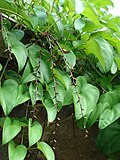Dioscorea alata
Dioscorea alata, also known as the purple yam, ube, or water yam, is a species of yam (a type of perennial vine) that is native to Asia, Africa, Caribbean, and Latin America. It is one of the most widely distributed yam species, and is known for its vibrant purple color and high nutritional value.
Description[edit]
Dioscorea alata is a fast-growing, twining vine, reaching heights of up to 10 meters. The leaves are heart-shaped and the tubers are usually bright lavender in color, although they can also be white or purple. The tubers can grow up to a meter in length.
Cultivation[edit]
Dioscorea alata is cultivated for its edible tubers in many tropical and subtropical regions around the world. It is typically grown from small pieces of tuber, which are planted in the ground and allowed to sprout. The plant prefers well-drained soil and a sunny location.
Uses[edit]
The tubers of Dioscorea alata are a major source of carbohydrates and are also rich in vitamin C, potassium, and antioxidants. They are commonly used in a variety of dishes, including desserts, soups, and stews. In the Philippines, the purple yam is used to make a popular dessert called ube halaya.
Cultural Significance[edit]
In many cultures, Dioscorea alata holds significant cultural value. For example, in the Philippines, it is a common ingredient in many traditional dishes and is often associated with celebrations and festivals.
See Also[edit]
References[edit]
<references />
This plant related article is a stub. You can help WikiMD by expanding it.
-
Dioscorea alata
-
Dioscorea alata
-
Dioscorea alata
-
Dioscorea alata
-
Dioscorea alata
-
Dioscorea alata
Ad. Transform your life with W8MD's Budget GLP-1 injections from $75


W8MD offers a medical weight loss program to lose weight in Philadelphia. Our physician-supervised medical weight loss provides:
- Weight loss injections in NYC (generic and brand names):
- Zepbound / Mounjaro, Wegovy / Ozempic, Saxenda
- Most insurances accepted or discounted self-pay rates. We will obtain insurance prior authorizations if needed.
- Generic GLP1 weight loss injections from $75 for the starting dose.
- Also offer prescription weight loss medications including Phentermine, Qsymia, Diethylpropion, Contrave etc.
NYC weight loss doctor appointmentsNYC weight loss doctor appointments
Start your NYC weight loss journey today at our NYC medical weight loss and Philadelphia medical weight loss clinics.
- Call 718-946-5500 to lose weight in NYC or for medical weight loss in Philadelphia 215-676-2334.
- Tags:NYC medical weight loss, Philadelphia lose weight Zepbound NYC, Budget GLP1 weight loss injections, Wegovy Philadelphia, Wegovy NYC, Philadelphia medical weight loss, Brookly weight loss and Wegovy NYC
|
WikiMD's Wellness Encyclopedia |
| Let Food Be Thy Medicine Medicine Thy Food - Hippocrates |
Medical Disclaimer: WikiMD is not a substitute for professional medical advice. The information on WikiMD is provided as an information resource only, may be incorrect, outdated or misleading, and is not to be used or relied on for any diagnostic or treatment purposes. Please consult your health care provider before making any healthcare decisions or for guidance about a specific medical condition. WikiMD expressly disclaims responsibility, and shall have no liability, for any damages, loss, injury, or liability whatsoever suffered as a result of your reliance on the information contained in this site. By visiting this site you agree to the foregoing terms and conditions, which may from time to time be changed or supplemented by WikiMD. If you do not agree to the foregoing terms and conditions, you should not enter or use this site. See full disclaimer.
Credits:Most images are courtesy of Wikimedia commons, and templates, categories Wikipedia, licensed under CC BY SA or similar.
Translate this page: - East Asian
中文,
日本,
한국어,
South Asian
हिन्दी,
தமிழ்,
తెలుగు,
Urdu,
ಕನ್ನಡ,
Southeast Asian
Indonesian,
Vietnamese,
Thai,
မြန်မာဘာသာ,
বাংলা
European
español,
Deutsch,
français,
Greek,
português do Brasil,
polski,
română,
русский,
Nederlands,
norsk,
svenska,
suomi,
Italian
Middle Eastern & African
عربى,
Turkish,
Persian,
Hebrew,
Afrikaans,
isiZulu,
Kiswahili,
Other
Bulgarian,
Hungarian,
Czech,
Swedish,
മലയാളം,
मराठी,
ਪੰਜਾਬੀ,
ગુજરાતી,
Portuguese,
Ukrainian





